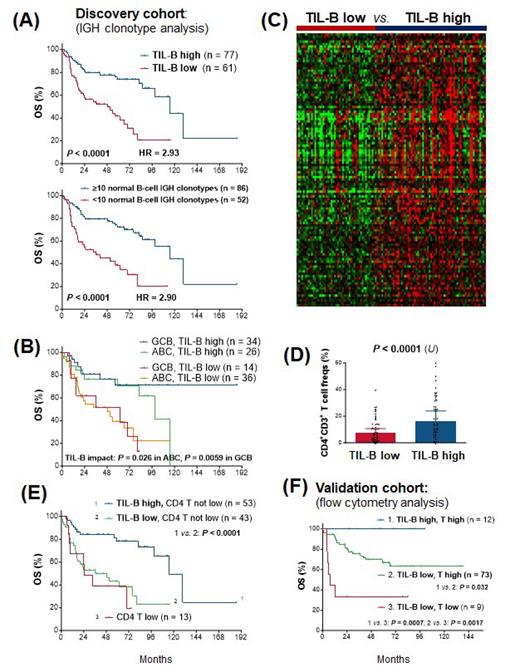Introduction: In recent years, increasing evidence suggests an important role of tumor-infiltrating B lymphocytes (TIL-Bs) in cancer immunity. In various types of solid tumors, high density of TIL-Bs and presence of mature tertiary lymphoid structures consistently correlate with better prognosis and response to immune checkpoint blockade therapies. Diffuse large B-cell lymphoma (DLBCL) is a type of aggressive lymphoma arising from mature B cells. TIL-Bs have been identified in DLBCL based on single-cell gene-expression data in several previous studies, but their prognostic significance in DLBCL is unknown. In this study, we determined the clinical significance of TIL-B abundance and investigated the potential underlying mechanisms.
Patients and Methods: This abstract includes a discovery study in which we distinguished TIL-Bs from malignant B-cells by immunoglobulin gene (IG) clonotype analysis and a validation study using flow cytometry. In the discovery study, a molecularly well-characterized DLBCL cohort assembled by the International DLBCL R-CHOP Consortium Program was analyzed. DNA samples from DLBCL patients were sequenced by high-throughput ultra-deep sequencing assays using multiplexed forward and reverse primers. Based on the IG heavy chain (IGH) sequencing results, malignant B-cell and TIL-B VDJ clonotypes were identified for 138 patients, and the frequencies and numbers of TIL-B clonotypes in individual sequence repertoires were calculated. In 79 DLBCL cases, a DJ-only sequence was predominant and no productive VDJ sequences met the criteria for diagnostic sequences. Total frequencies of productive VDJ sequences in the sequence repertoires were then used to access high and low TIL-B frequencies. TIL-B frequencies were also evaluated by IG light chain clonotypes for these 217 patients and additional 52 patients. The TIL-B frequencies were correlated with patient survival, gene-expression profiling (GEP) data GSE31312, and frequencies of DLBCL-infiltrating immune cells quantified by fluorescent multiplex immunohistochemistry (mIHC). To validate the prognostic significance of TIL-B frequencies, we assembled a validation cohort of 94 DLBCL patients treated at Duke University Medical Center. TIL-Bs in tissues were quantified by flow cytometry immunophenotyping. Ratios of TIL-Bs to abnormal B cells were assessed for prognostic effects.
Results: First, we found thathigh frequencies of TIL-Bs and clonotypic diversity were associated with significantly favorable prognostic effects in 138 DLBCL patients with their malignant B-cell IGH-VDJ clonotypes identified (Figure A). The prognostic effects of TIL-Bs outweighed those of the germinal center B-cell-like/activated B-cell-like classification (Figure B). Second, patients with high frequencies of TIL-Bs compared with those without had significant upregulation of immune response genes by GEP (Figure C), higher CD4 T cell infiltration quantified by fluorescent mIHC (Figure D), and enrichment of EcoTyper-defined specific cell states, including significantly increased frequencies of B cell state S2 (pre-memory), CD4 T cell state S3 (naïve), follicular helper T cell state S3, and endothelial cell state S3, whereas lower frequencies of B cell state S5 (plasmablast) and follicular helper T cell state S1. Third, high TIL-B abundance in 79 ‘DJ-only’ clonotype cases and additional 52 cases assessed by light chain clonotype analysis showed similar favorable prognostic effects and associations with upregulated immune gene expression and CD4 T cell infiltration. Fourth, the identified GEP signatures, prominent with genes involved in T-dependent B cell activation and T cell activation and differentiation, showed significant prognostic effects in two GEO datasets. Fifth, TIL-B abundance showed significant prognostic effects in DLBCL cases infiltrated with T-cells in both the discovery study (Figure E) and validation study (Figure F, flow cytometry cohort).
Conclusions: TIL-B frequencies and clonotypic diversity have remarkable prognostic and biological effects in DLBCL, which has significant implications for developing novel therapeutic strategies. Our study identified a new prognostic biomarker in DLBCL and an important player in anti-lymphoma immune responses, providing a new point of view to analyze the tumor biology in aggressive B-cell lymphoma and precisely identify prognostic determinants.
Disclosures
Snyder:Adaptive Biotechnologies: Ended employment in the past 24 months. Hsi:Novartis: Consultancy. Ponzoni:ABBVIE: Honoraria; Roche Ventana Diagnostics: Consultancy, Honoraria. Ferreri:Adienne: Speakers Bureau; ADC Therapeutics, Amgen, BeiGene, BMS, Genmab, Gilead, Hutchison Medipharma, Novartis, Pharmacyclics, PentixaPharm, Pfizer, Roche: Research Funding; Gilead, Incyte, Novartis, PentixaPharm, Roche: Consultancy; Ospedale San Raffaele srl.: Patents & Royalties. Au:NeoGenomics Laboratories: Current Employment. Kirsch:Adaptive Biotechnologies: Consultancy.


